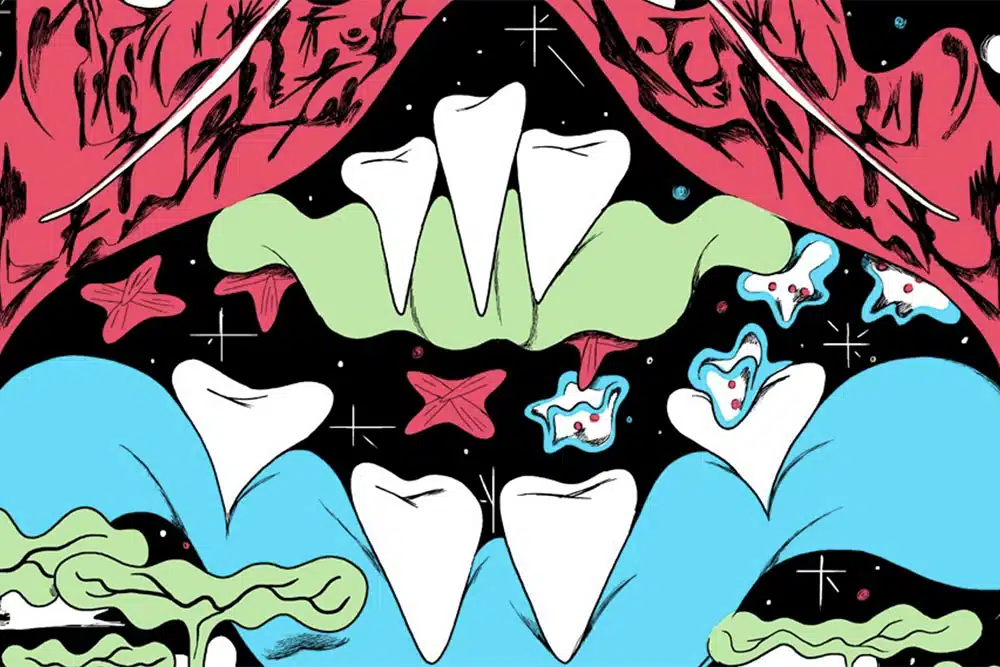
With its title, Michael DeForge’s Heaven No Hell promises 200+ pages of paradise. Though the comics contained within its beautifully bound and designed hardcover volume indeed exhibit his artistic growth over the past ten years of his career, it’s immediately apparent that artistic evolution alone cannot explain what is found within.
With Heaven No Hell, DeForge relishes in exposing his prowess as an intelligent designer. His collection, an assortment of rich, complicated, and grandiose narratives, is founded upon his aptitude for poignant societal deconstruction, coupled with unrestrained character-driven narratives and, as long-time readers of his work have come to expect, his incomparable virtuosic use of abstracted-style cartooning.
Through 17 short comics, DeForge guides the reader through a relentless journey of philosophical quandary and political exploration that, though thematically and ideologically connected, alternate mood, tone, and genre at an almost disorienting pace. From everyday thriller (“Role Play”) to existential and revelatory (“No Hell), from murder mystery (“One of my Students is a Murderer… But Which?”) to sci-fi allegory (“My New Stepdad is a Disgusting Bug, and I Hate Him”), each new comic feels like a perfect fit for DeForge, as he takes the best that the genre has to offer and forces it to dance with his personal artistic style.
An abstract cartoonist, DeForge’s shapes, colors, icons, symbols, lines, and spaces all collaborate as much, if not more, than the words and narrative content of each story. In Heaven No Hell, his first short comics collection, DeForge is free to push the boundaries of his style even further; while some comics lean closer towards recognizable cartooning, others are experimentally abstracted and delightfully surreal.
One such comic, “New Museum”, can be read as DeForge’s personal artistic and political manifesto: “Every realist was, at last, maimed, beheaded, or crushed under boulders. No more hand-wringing; we lopped off their hands. The mealy-mouthed had their tongues forcibly tied. We fed their appendages to dogs, finally making themselves useful for once” (p. 125).
Detailing a revolution between “the pragmatic, the sensible, the even-handed, the fence-sitting, the well-wishing” (otherwise known as “the reasonable”) and “the depressive, the hysterical, the exuberant, the miserable, the terrified, the obsessive, the delusional” (or “the unreasonable”), “New Museum” tells the tale of an anarchic utopia through the lens of what might be DeForge’s most experimental abstract style to date (p. 126). Of course, this is by design, and the form of the comic is as important to understanding the world of “New Museum” as the recounting of the revolution itself.
Another of the collection’s best, “Recommended For You”, foregoes the extreme abstractions in favor of a more stylized, but no less poignant, political commentary. It tells the story of a fictional television program (“Day of Reckoning”) that takes the premise of our world’s The Purge media and flips it on its head. Rather than a single day of legal crime and mayhem, DeForge’s “Day of Reckoning” has a single day of lawfulness.
Riddled with cartoon depictions of violence, crime, corruption, and debauchery that juxtapose the off-panel discussion of the viewers (as one character says, “People are letting their dogs shit wherever…” another replies, “And they aren’t picking it up? With a doggy bag?), “Recommended For You” challenges societal assumptions about good and evil/kindness and cruelty. It asks readers to witness the divide between what we see ourselves and others doing (the visual) and what is actually happening (the narrative).
The collection’s final comic, “Soap Opera”, is a damning meditation on both our constant search for the new, next best thing and our glorification of the past. The panel content feels much less like active agents of closure and more like vignettes from the nameless character’s life in this short comic, because of its two-panel per page spatial layout with captions beneath. It works brilliantly, because rather than feeling as though we are reading his exploits, it feels as though we are intruding on his exploits.
His actions throughout the story are, in no way, defensible, but DeForge refuses to let readers off the hook easily and contrives instead for us to implicate ourselves in the character’s actions. We are watching him, savoring his drama, judging his choices, but living our lives no differently as we recklessly barrel towards the newest gadget and the smartest devices. Yet, the story comes full circle in the end as DeForge takes pleasure in pulling the rug from under readers, critiquing our impulses to reify through nostalgic longing the things that we once discarded as outdated.
With each comic, Heaven No Hell succeeds in challenging a different previously concretized notion about art, politics, society, meaning, culture, and even the way we understand ourselves and what matters to us. One of Canada’s most prolific cartoonists (this is his 11th comics book in ten years), DeForge continues to elevate not only his art with each new book, but also our expectations for what the medium is capable of accomplishing when rocketed beyond its rigid and traditional scope.
Few cartoonists are bold enough to promise heaven. DeForge not only promises it, but he also delivers us to it.

